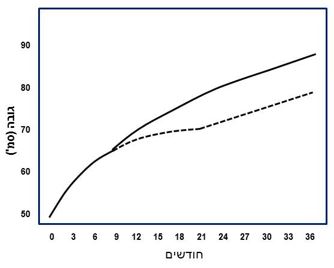Technion, TAU and Bnai Zion: Infants’ environments play key role in their heights as adults

If you have ever wondered why you are not a little taller, it turns out it’s not all about genetics. In findings an Israeli research team shows that the environment in which one lives from the womb to about age one largely determines an adult’s height. The pioneering study was conducted by researchers at the Technion-Israel Institute of Technology, Tel Aviv University and Bnai Zion Hospital, in collaboration with Regional Health Offices in Haifa and Tel Aviv.

The growth chart of the child on the solid line transitioned from infancy to childhood at age 9 months, while the growth chart of the child on the dotted line transitioned at age 20 months. The difference in their height at age 3 is 10 cm (about 4 inches). No differences between them are shown within the actual stages of either infancy or childhood, only in the timing of the transition between phases. The new discovery shows that this delay is affected only by environmental conditions, and not by genetic factors
Led by Professor Ze’ev Hochberg and Dr. Alina German, of the Technion’s Ruth and Bruce Rappaport Faculty of Medicine, the team found that while genetics do have a significant effect on a person’s height, so, too, do environmental elements that include the environment in the womb, nutrition and health status in the first year of life, parents and family structure, and economic and emotional events.
“Following the genetics revolution, today it is customary to attribute our personal traits to the genes,” explains Prof. Hochberg. “Indeed, there is no doubt that many of our features are genetic. However, as can be seen in our study, environmental conditions have a very significant role – around 50 percent – in determining growth and height.” The range-difference between people who are tall or short is about 10 inches in men and 9 inches in women. Half of the variation is set at a decisive growth stage – when the child transits from infantile growth to childhood and the new study shows that this part is due only to environmental conditions before birth and during infancy. The researchers determined this phase transition in 162 sets of twins [56 pairs of identical twins (who have identical genes), 106 pairs of fraternal twins (who share only half their genes)], and 106 pairs of non-twin siblings, who also share half their genes.
“Studies on twins let us test the balance between genes and the environment,” explains Prof. Hochberg. “The difference between identical and fraternal twins shows the impact of genetics. Here we discovered the remarkable power of the environment in shaping a person. This is called plasticity in human development, which means that environmental conditions such as mother and baby nutrition, social and family interactions, can influence our growth and height.”
From an evolutionary perspective, say the researchers, this plasticity helps ‘shape’ characteristics to suit future living conditions, which are ‘adaptively predicted’ based on current conditions. For example, “children who are born into and grow up in a malnourished environment will be shorter, and therefore require less food as they get older, while children born into a well-nourished environment will grow to be tall,” says Prof. Hochberg.
The research team also included Prof. Zvi Livshitz, Dr. Ida Malkin and Dr. Inga Peter from Tel Aviv University; Dr. Yonatan Dubnov and Dr. Hana Akones from Haifa’s Regional Health Office, and Dr. Michael Shmoish of the Lorry I. Lokey Interdisciplinary Center for Life Sciences and Engineering at the Technion.
Publication in the Journal of Pediatrics, January 2015




